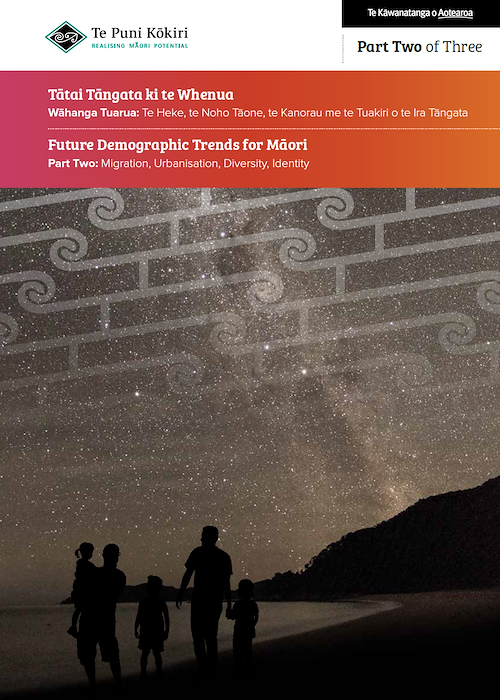Long-term Insights Briefing 2023
The Public Service Act 2020 requires all department chief executives to publish a Long-term Insights Briefing at least once every three years. Our LTIB presents a series of evidence-based scenarios depicting whānau wellbeing and contemplating a medium to long-term future as seen through a Māori lens. The LTIB is an opportunity to enhance public conversations about long-term issues and to meaningfully contribute to future decision-making.
Future Demographic Trends for Māori – Part Two
Future Demographic Trends for Māori – Part Two is the second in a series of three reports by Te Puni Kōkiri which collate a range of baseline population statistics, trends and projections for Māori.
Te Puni Kōkiri: Tāmaki Makaurau Regional Profile 2017
Te Puni Kōkiri measures a range of outcomes that fall within Whakapapa (te reo Māori and connection to iwi), Oranga (whānau well-being and whānau housing), Whairawa (whenua and whanaketanga), and Whanaungatanga (Crown-Māori relationships). This publication provides an insight into the growth and development of Māori within these outcomes in the Tāmaki Mākaurau region.
Te Puni Kōkiri: Ikaroa-Rāwhiti Regional Profile 2017
Te Puni Kōkiri measures a range of outcomes within Whakapapa (te reo Māori and connection to iwi), Oranga (whānau well-being and whānau housing), Whairawa (whenua and whanaketanga), and Whanaungatanga (Crown-Māori relationships). This publication provides an insight into the growth and development of Māori within these outcomes in the Ikaroa-Rāwhiti region.
Te Puni Kōkiri: Te Tai Tokerau Regional Profile 2017
Te Puni Kōkiri measures a range of outcomes within Whakapapa (te reo Māori and connection to iwi), Oranga (whānau well-being and whānau housing), Whairawa (whenua and whanaketanga), and Whanaungatanga (Crown-Māori relationships). This publication provides an insight into the growth and development of Māori within these outcomes in the Te Tai Tokerau region.
Te Puni Kōkiri: Te Tai Hauāuru Regional Profile 2017
Te Puni Kōkiri measures a range of outcomes that fall within Whakapapa (te reo Māori and connection to iwi), Oranga (whānau well-being and whānau housing), Whairawa (whenua and whanaketanga), and Whanaungatanga (Crown-Māori relationships). This publication provides an insight into the growth and development of Māori within these outcomes in the Te Tai Hauāuru region.
Future Demographic Trends for Māori – Part One
Future Demographic Trends for Māori – Part One is the first in a series of three reports by Te Puni Kōkiri which collate a range of baseline population statistics, trends and projections for Māori.
Te Puni Kōkiri: Waikato-Waiariki Regional Profile 2017
Te Puni Kōkiri measures a range of outcomes that fall within Whakapapa (te reo Māori and connection to iwi), Oranga (whānau well-being and whānau housing), Whairawa (whenua and whanaketanga), and Whanaungatanga (Crown-Māori relationships). This publication provides an insight into the growth and development of Māori within these outcomes in the Waikato-Waiariki region.
Te Puni Kōkiri: Te Waipounamu Regional Profile 2017
Te Puni Kōkiri measures a range of outcomes that fall within Whakapapa (te reo Māori and connection to iwi), Oranga (whānau well-being and whānau housing), Whairawa (whenua and whanaketanga), and Whanaungatanga (Crown-Māori relationships). This publication provides an insight into the growth and development of Māori within Te Waipounamu and within these outcomes.








